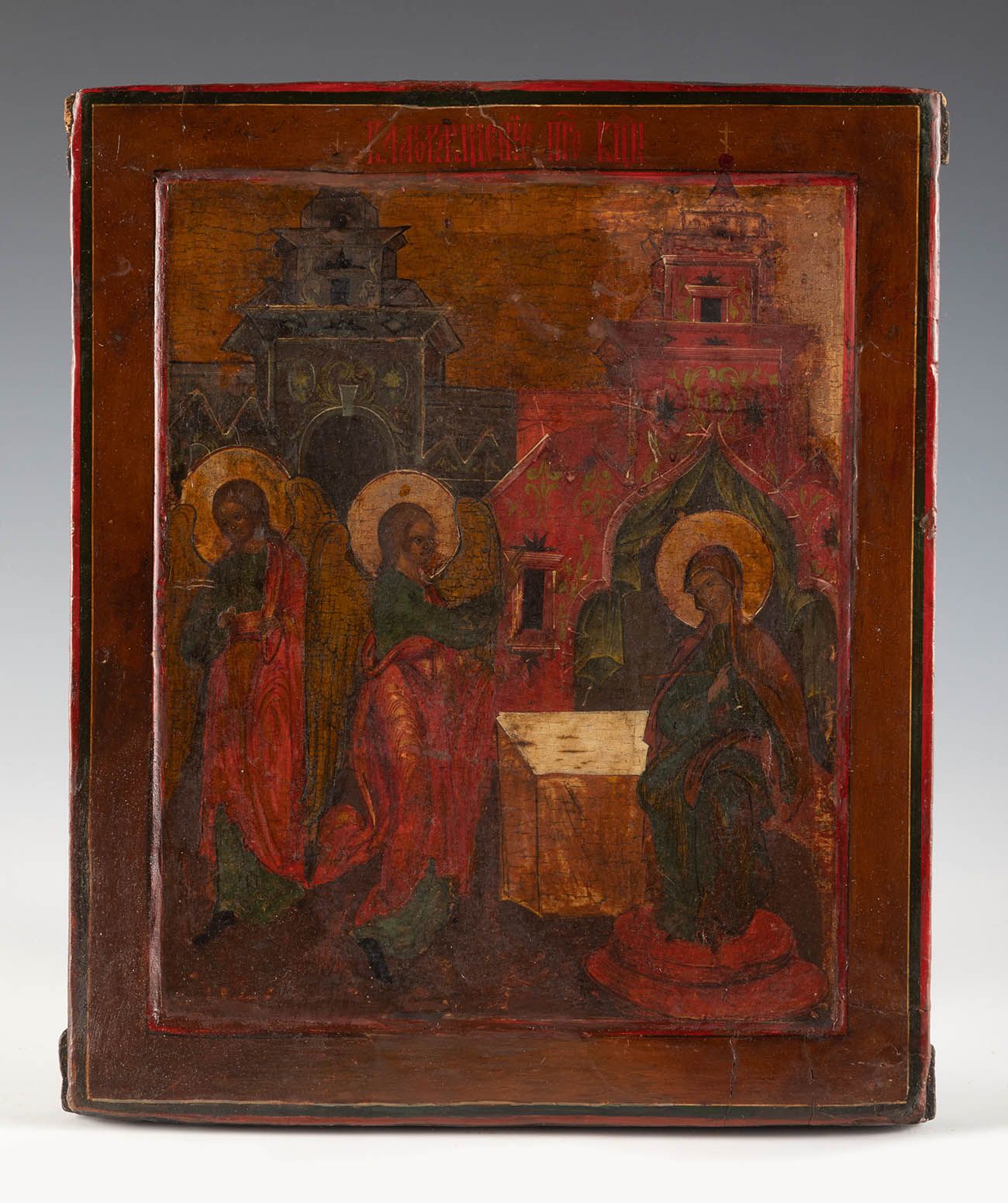Description
Russian school, late 18th century. "Annunciation". Tempera, gold leaf on panel. Measurements: 32 x 16,5 cm. The icon of interest represents the scene of the Annunciation, with the Virgin seated on the throne on the left, and with a double representation of the Archangel Gabriel on the right. The painter uses this unusual technique to convey the sensation of movement and to give the scene dynamism and continuity. Architectural motifs can be found in the background, signifying that the scene takes place inside the church itself. It is a characteristic feature of orthodox iconography to depict interior scenes on the outside of the building. The painters resorted to this metaphysical trick, not in search of visual verisimilitude, but in order to be able to tell the believers as much information about the scene as possible through the two-dimensional medium. The chromatic range of the icon, the typology of the faces and the architecture, as well as the study of the materials, especially the wood, help to place it chronologically towards the end of the 18th century. The Annunciation, described in the Gospel of Luca, represents one of the most beautiful scenes in the New Testament, when the Archangel Gabriel announces to the Virgin Mary that she is to be the mother of God. In Christian iconography there is a traditional compositional canon, which may differ slightly depending on the school or period. In Orthodox painting there are three variations of the Annunciation: at the well, with a spindle and in the church. The most common model is the latter, known as "in the church", to which the present icon belongs. This prototype developed in Russia around the beginning of the 16th century. The Virgin seated on the throne, the variation is accepted standing, head bowed, with an affectionate gaze, and she is approached by Archangel Gabriel with the good news. His right hand is raised in a gesture of blessing. Architectural elements usually appear in the background. In the Orthodox tradition, the depiction of the Annunciation is adopted from the Byzantine world, and has been known from very early times. The first depictions of this scene decorated the early Orthodox cathedrals of Old Rus. Among the most famous frescoes is the one in St Sophia Cathedral in Kiev. Later, around the 15th century, this iconography was represented in easel art, medium-sized panel icons.
37
Russian school, late 18th century. "Annunciation". Tempera, gold leaf on panel. Measurements: 32 x 16,5 cm. The icon of interest represents the scene of the Annunciation, with the Virgin seated on the throne on the left, and with a double representation of the Archangel Gabriel on the right. The painter uses this unusual technique to convey the sensation of movement and to give the scene dynamism and continuity. Architectural motifs can be found in the background, signifying that the scene takes place inside the church itself. It is a characteristic feature of orthodox iconography to depict interior scenes on the outside of the building. The painters resorted to this metaphysical trick, not in search of visual verisimilitude, but in order to be able to tell the believers as much information about the scene as possible through the two-dimensional medium. The chromatic range of the icon, the typology of the faces and the architecture, as well as the study of the materials, especially the wood, help to place it chronologically towards the end of the 18th century. The Annunciation, described in the Gospel of Luca, represents one of the most beautiful scenes in the New Testament, when the Archangel Gabriel announces to the Virgin Mary that she is to be the mother of God. In Christian iconography there is a traditional compositional canon, which may differ slightly depending on the school or period. In Orthodox painting there are three variations of the Annunciation: at the well, with a spindle and in the church. The most common model is the latter, known as "in the church", to which the present icon belongs. This prototype developed in Russia around the beginning of the 16th century. The Virgin seated on the throne, the variation is accepted standing, head bowed, with an affectionate gaze, and she is approached by Archangel Gabriel with the good news. His right hand is raised in a gesture of blessing. Architectural elements usually appear in the background. In the Orthodox tradition, the depiction of the Annunciation is adopted from the Byzantine world, and has been known from very early times. The first depictions of this scene decorated the early Orthodox cathedrals of Old Rus. Among the most famous frescoes is the one in St Sophia Cathedral in Kiev. Later, around the 15th century, this iconography was represented in easel art, medium-sized panel icons.
